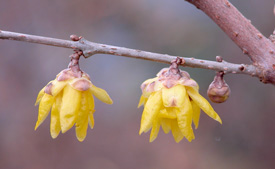Tip of the Week — 1/5/09
Posted in Gardening Tips on January 5 2009, by Sonia Uyterhoeven
Fragrant Wintersweet (Chimonanthus praecox)
 Sonia Uyterhoeven is Gardener for Public Education at The New York Botanical Garden.
Sonia Uyterhoeven is Gardener for Public Education at The New York Botanical Garden.
 They say that nature is about observation, but sometimes it is about just following your nose. Chimonanthus praecox is one such example. It is an underused winter flowering shrub that is often eclipsed by the more popular Hamamelis (witch hazel).
They say that nature is about observation, but sometimes it is about just following your nose. Chimonanthus praecox is one such example. It is an underused winter flowering shrub that is often eclipsed by the more popular Hamamelis (witch hazel).
Fragrant wintersweet is a deciduous shrub that is hardy to zone 6b. It tends to be a multi-stemmed, loose-stemmed specimen with a fountain or vase-like shape. It does not have the structural composure that witch hazel possesses. It can get a little gangly with age. Happily, this 10- to 15-foot shrub can be severely cut back after flowering.
The main feature of this shrub is its fragrant winter bloom. It just started flowering in the Home Gardening Center (it’s planted behind the Sensory Garden) in mid-December and should remain in flower through the cold winter months.
It has small half-inch to 1-inch long flowers that look like shredded little cups. The inflorescence (floral structure) is broken down into layers. The outer layer has flat strap-like, waxy, yellowish-white, translucent tepals. The smaller tepals on the inner layer are burgundy. They are also translucent and remind me of what a first coat of burgundy nail polish looks like on your nails. What’s a tepal? It is the botanist’s name for when the flower part (sepals and petals) all look undifferentiated.
Never mind the anatomy, how about the fragrance? It has a pungent smell that is spicy and exotic. It reminds me of ylang ylang, the type of fragrance that gets trapped inside your nostrils.
With its pungent perfume and its poetic little flowers, can we then speculate on how Chimonanthus is pollinated? The general rule of thumb is that trees and shrubs with small, inconspicuous flowers are most likely wind pollinated. They don’t need to put on a show to attract a pollinator; they simply need to extend their branches so their pollen can get caught in a passing gust of wind.
Woody specimens with large, showy flowers and enticing perfumes tend to be insect pollinated. They lure their potential pollinators with sweet smells and sugary nectars. But who in their right mind would be flying about in the middle of winter?
When we look to other winter-flowering shrubs for clues, we are given none. Members of the Hamamelidaceae family such as witch hazel produce fragrant flowers during the winter. These woody plants are wind pollinated, although, curiously enough, fossil evidence indicates the possibility they were once insect pollinated.
Chimonanthus praecox is in the Calycanthaceae family. Members of this family are generally either fly or beetle pollinated. Small, open flowers tend to be fly pollinated while larger, intricate flowers are designed to trap beetles.
Is this exotically fragrant shrub then fly pollinated? The burgundy markings on the inner tepals and its graceful open whorl-like floral structure would suit that pollinator. But in the middle of winter?
Maybe in its native China there are small hovering flies or beetles buzzing around when the shrub is in flower. Here in New York, however, we have decided that Chimonanthus praecox is “nose-pollinated.” That is, it’s fragrance is so enticing that once you dip your nose in for a small whiff you will be back for more.

